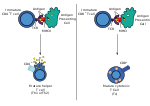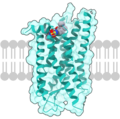Search results
Appearance
There is a page named "CXCR5" on Wikipedia
- cell zones. In humans, the CXC-R5 protein is encoded by the CXCR5 gene. The BLR1 / CXCR5 gene is specifically expressed in Burkitt's lymphoma and lymphatic...15 KB (1,956 words) - 21:30, 13 August 2023
- CXC chemokine receptors (section CXCR5)vascular endothelial cells and neuronal/nerve cells. The chemokine receptor CXCR5 is expressed on B cells and CD4+ Tfh cells and is involved in lymphocyte...9 KB (885 words) - 07:16, 30 April 2024
- with CXCR5+CD8+T cells show a significant decrease of HBsAg. Also, an increase of CXCL13 levels facilitated the recruitment of intrahepatic CXCR5+CD8+T...31 KB (3,843 words) - 08:24, 16 June 2024
- elicits its effects by interacting with chemokine receptor CXCR5. CXCL13 and its receptor CXCR5 control the organization of B cells within follicles of lymphoid...4 KB (518 words) - 21:19, 21 November 2023
- Among other homeostatic chemokine receptors include: CCR9, CCR10, and CXCR5, which are important as part of the cell addresses for tissue-specific homing...30 KB (2,916 words) - 11:52, 3 December 2023
- TNIP1, and CXCR5. This also suggested the activation of the innate immune system, notably through the IFN system, B-cell activation through CXCR5-directed...85 KB (9,050 words) - 01:29, 26 June 2024
- Mavorixafor Plerixafor (AMD3100) Antibodies: Ulocuplumab (against CXCR4) CXCR5 Agonists: CXCL13 CXCR6 Agonists: CXCL16 CXCR7 Agonists: CXCL11 (I-TAC) SDF-1...98 KB (11,068 words) - 14:03, 2 July 2024
- by their constitutive expression of the B cell follicle homing receptor CXCR5. Upon cellular interaction and cross-signaling with their cognate follicular...16 KB (1,936 words) - 01:42, 16 December 2023
- Lipp M (June 2003). "Shaping up adaptive immunity: the impact of CCR7 and CXCR5 on lymphocyte trafficking". Microcirculation. 10 (3–4): 325–334. doi:10...21 KB (2,527 words) - 21:14, 6 April 2024
- (C-X-C motif) receptor 4 (CXCR4, Fusin) Chemokine (C-X-C motif) receptor 5 (CXCR5) Chemokine (C-X-C motif) receptor 6 (CXCR6, BONZO) Chemokine (C-X-C motif)...25 KB (2,172 words) - 01:01, 29 November 2023
- proteins like IRF4 commences production of Tfh indespensable molecules: CXCR5, ICOS, Bcl6 and IL-21. Tfh cells express high levels of NFATc1 and especially...23 KB (2,877 words) - 23:41, 26 April 2024
- in turn, attract B cells with chemoattractant CXCL13. B cells lacking CXCR5, the receptor for CXCL13, still enter the white pulp, but are mislocalized...16 KB (1,896 words) - 15:59, 6 April 2024
- their expression of appropriate marker proteins (e.g. PD-1, ICOS, CXCL13, CXCR5, and TOX).[citation needed] No controlled studies on the treatment of the...139 KB (16,931 words) - 12:00, 25 June 2024
- Mavorixafor Plerixafor (AMD3100) Antibodies: Ulocuplumab (against CXCR4) CXCR5 Agonists: CXCL13 CXCR6 Agonists: CXCL16 CXCR7 Agonists: CXCL11 (I-TAC) SDF-1...14 KB (1,637 words) - 02:07, 3 December 2023
- Müller G (2003). "Shaping up adaptive immunity: the impact of CCR7 and CXCR5 on lymphocyte trafficking". Verhandlungen der Deutschen Gesellschaft für...67 KB (7,846 words) - 08:25, 22 June 2024
- BLRC (disambiguation) Burkitt lymphoma receptor 1 (BLR1), also known as CXCR5 This disambiguation page lists articles associated with the title BLR. If...1 KB (161 words) - 23:04, 24 January 2023
- / CCRL1 CCR2 CCRL2 CCR3 CCR4 CCR5 CCR6 CCR7 CCR8 CCR9 CCR10 CXC IL-8 CXCR1 CXCR2 CXCR3 CXCR4 CXCR5 CXCR6 CXCR7 Other CX3C CX3CR1 XC XCR1 CCBP2 CMKLR1...28 KB (3,133 words) - 02:13, 17 June 2024
- / CCRL1 CCR2 CCRL2 CCR3 CCR4 CCR5 CCR6 CCR7 CCR8 CCR9 CCR10 CXC IL-8 CXCR1 CXCR2 CXCR3 CXCR4 CXCR5 CXCR6 CXCR7 Other CX3C CX3CR1 XC XCR1 CCBP2 CMKLR1...30 KB (3,687 words) - 20:28, 17 May 2024
- Mavorixafor Plerixafor (AMD3100) Antibodies: Ulocuplumab (against CXCR4) CXCR5 Agonists: CXCL13 CXCR6 Agonists: CXCL16 CXCR7 Agonists: CXCL11 (I-TAC) SDF-1...19 KB (2,415 words) - 10:02, 2 June 2024
- / CCRL1 CCR2 CCRL2 CCR3 CCR4 CCR5 CCR6 CCR7 CCR8 CCR9 CCR10 CXC IL-8 CXCR1 CXCR2 CXCR3 CXCR4 CXCR5 CXCR6 CXCR7 Other CX3C CX3CR1 XC XCR1 CCBP2 CMKLR1...9 KB (934 words) - 09:24, 27 March 2022
- factor Bcl6. Distinguishing features of TFH cells are the expression of CXCR5, PD-1, SAP (SH2D1A), IL-21, and ICOS, among other molecules, and the absence
- net/health/What-are-Chemokines.aspx * Process of b/t cell proliferation Key role of CXCL13/CXCR5 axis for cerebrospinal fluid B cell recruitment in pediatric OMS Pranzatelli
















